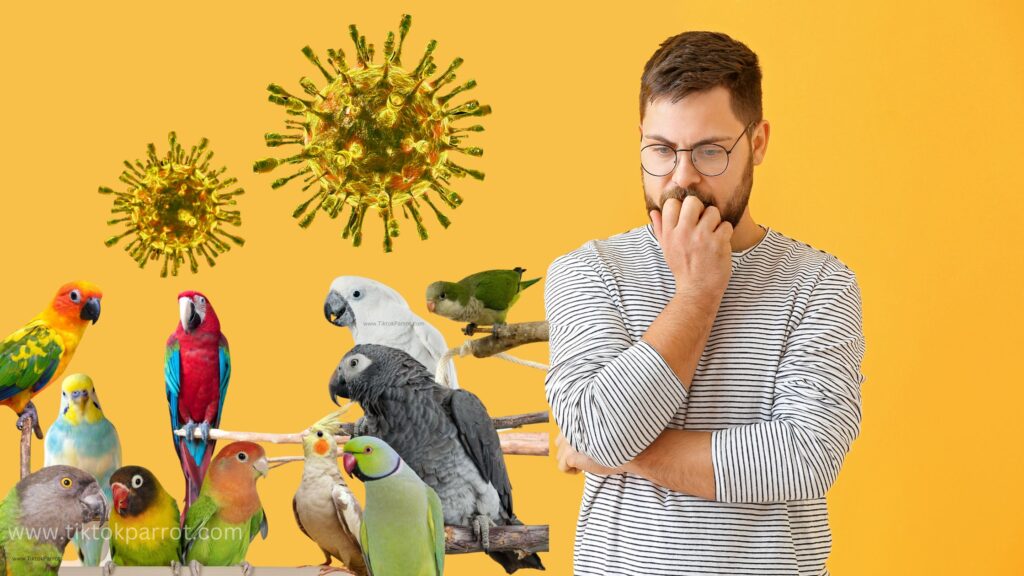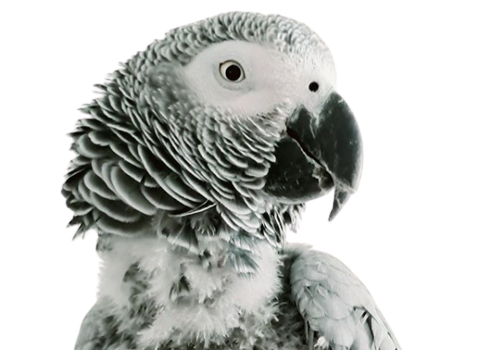Today, we’re diving into a topic that’s no fun for anyone – salmonella in birds. Now, before you envision your perfectly preened parrot turning into a grumpy green blob (trust us, it wouldn’t be a good look!), let’s break down the facts and get you feeling confident in caring for your feathered friend.
Understanding Salmonella, Symptoms, and Prevention for a Happy Flock! Keep Your Feathered Friends Healthy and Happy.
Salmonella – it sounds like something straight out of a scary movie script, right? But fear not, knowledge is power! In a nutshell, salmonella is a type of bacteria that can cause some nasty tummy troubles in both humans and, unfortunately, our avian companions.
So, How Does This Tiny Terror Get Into My Bird’s Tummy?

Imagine your parrot as a feathered explorer, curiously pecking at everything in sight. Unfortunately, this adventurous spirit can sometimes lead them to some not-so-delicious discoveries. Here are the usual culprits:
Imagine your parrot as a feathered explorer, curiously pecking at everything in sight. Unfortunately, this adventurous spirit can sometimes lead them to some not-so-delicious discoveries. Here are the usual culprits:
- Contaminated Food: Spoiled or expired seeds, fruits, or vegetables can harbor this sneaky bacteria. Think of it as a stale cracker gone rogue!
- Dirty Water: Stagnant or unclean water sources are a breeding ground for all sorts of nasties, including salmonella. Your parrot’s water dish needs a daily refresh, just like your own water bottle!
- Contact with Infected Birds: Birds, like humans, can carry salmonella without showing any symptoms. A friendly chirp with a sick neighbor at the park could lead to an unwelcome passenger hitching a ride on your feathered friend.
- Contaminated Environment: Salmonella can linger on surfaces like cages, toys, and even your hands. Proper cleaning is key to keeping your parrot’s play zone squeaky clean!
Uh Oh, My Parrot Seems Under the Weather! What Are the Signs?
Just like us, birds show signs when they’re feeling under the weather. Here’s what to watch out for:
- Diarrhea: This is a classic sign of a troubled tummy. Imagine your parrot’s usual, neat droppings turning into a watery mess – not a pleasant sight!
- Lethargy: Is your usually energetic parrot suddenly napping more than usual? This lack of energy can be a sign of illness.
- Loss of Appetite: Imagine your parrot turning up his beak at his favorite treats – that’s a red flag! A healthy bird should be excited about mealtime.
- Fluffed Feathers: A puffed-up appearance can indicate discomfort or illness. Think of it as your parrot wearing a feathery bathrobe – a sign they’re not feeling their best.
What does Salmonella look like in birds?
Salmonella infection in birds doesn’t have a specific visual appearance. Instead, it manifests through various symptoms such as diarrhea, lethargy, loss of appetite, and fluffed feathers. These signs indicate that the bird is unwell and may be suffering from a salmonella infection. It’s essential to monitor your bird’s behavior and seek veterinary care if you notice any unusual symptoms.
Don’t Panic! What Can I Do to Help My Feathered Friend?
If you suspect your parrot has salmonella, the first step is to seek professional help. A qualified veterinarian can diagnose the problem and recommend the best course of treatment. Antibiotics are often used to fight the bacterial infection, and fluids may be necessary to keep your bird hydrated.
Do birds recover from Salmonella?

Yes, birds can recover from Salmonella with appropriate veterinary care and treatment. The recovery process depends on various factors, including the severity of the infection, the bird’s overall health, and how quickly treatment is initiated.
Veterinarians typically prescribe antibiotics to treat Salmonella infections in birds. Additionally, supportive care such as fluid therapy may be necessary to help the bird stay hydrated and maintain its strength during recovery.
It’s crucial to follow your veterinarian’s advice closely, administer medications as prescribed, and provide a clean and comfortable environment for your bird. With proper treatment and care, many birds can recover fully from Salmonella infections. However, it’s essential to monitor their health closely and seek veterinary attention if any complications arise.
Prevention is Key: Keeping Your Parrot Salmonella-Free
Now, let’s talk about keeping that nasty bacteria at bay! Here are some simple steps you can take:
- Fresh Food and Water: Provide your parrot with fresh, clean food and water daily. Think of it as a five-star dining experience for your feathered friend!
- Cleanliness is Next to Godliness: Regularly clean your parrot’s cage, toys, and food and water dishes with a disinfectant solution safe for birds. Imagine giving your parrot’s play area a spa day – they’ll appreciate it!
- Wash Your Hands: Before and after handling your parrot, wash your hands thoroughly with soap and water. This simple step can help prevent the spread of bacteria.
- Quarantine New Birds: If you’re introducing a new feathered friend to your flock, quarantine them first to ensure they’re healthy. Think of it as a new student getting a check-up before joining the birdie classroom!
My Final Thoughts
Salmonella may not be the most pleasant topic, but by being informed and taking preventive measures, you can keep your feathered friend healthy and happy. Remember, early detection and veterinary care are crucial if your parrot does get sick.
Have you ever dealt with salmonella in your birds? Share your experiences, tips, and questions in the comments below. Together, we can create a healthy and happy environment for all our feathered friends!
If you found this blog helpful, It would be great if you could share it with your family and friends who might find it useful as well.
You might like to read these as well 🙂
E. coli Emergency: What Every Parrot Parent Needs to Know for a Safe Flock
Avian Tuberculosis in Birds – Signs, Prevention, And Treatment
Silent Spreader: The Scary Truth About Polyomavirus in Birds
Psittacine Beak and Feather Disease (PBFD) In Pet Birds
Understanding Chlamydia psittaci (Psittacosis) In Pet Birds
Understanding Pacheco’s Disease Symptoms, Transmission and Prevention
For more useful content about African grey parrots, you can subscribe my site with your email to get notification upon publishing a new blog, the subscribe box you can see on the right side of this page. Also if you get an alert on your web browser while browsing my site, allow it and that will also give you an alert whenever I publish a new blog. 🙂
Stay safe and much love!



